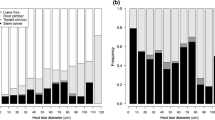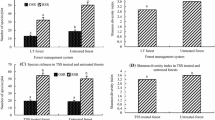Abstract
Lianas (woody vines) contribute substantially to the diversity and structure of most tropical forests, yet little is known about the importance of habitat specialization in maintaining tropical liana diversity and the causes of variation among forests in liana abundance and species composition. We examined habitat associations, species diversity, species composition, and community structure of lianas at Sepilok Forest Reserve, Sabah, Malaysia in northeastern Borneo among three soil types that give rise to three distinct forest types of lowland tropical rain forest: alluvial, sandstone hill, and kerangas (heath) forest. Alluvial soils are more nutrient rich and have higher soil moisture than sandstone soils, whereas kerangas soils are the most nutrient poor and drought prone. Lianas ≥0.5-cm in diameter were measured, tagged, and identified to species in three square 0.25-ha plots in each forest type. The number of lianas ≥0.5 cm did not differ significantly among forest types and averaged 1348 lianas ha−1, but mean liana stem diameter, basal area, estimated biomass, species richness, and Fisher’s \(\upalpha\) diversity index were all greater for plots in alluvial than sandstone or kerangas forests. Liana species composition also differed greatly among the three habitats, with 71% of species showing significant positive or negative habitat associations. Sandstone forests were intermediate to alluvial and kerangas forests in most aspects of liana community structure and composition, and fewer species showed significant habitat associations with this forest type. Ranking of forest types with respect to liana density, biomass, and diversity matches the ranking in soil fertility and water availability (alluvial > sandstone hill > kerangas). These results suggest that edaphic factors play an important role in maintaining liana species diversity and structuring liana communities.
Similar content being viewed by others
References
Acres B.D. and Folland C.J. (1975). The Soil of Sabah. Volume 2: Sandakan and Kinabatangan Districts. Land Resource Division, Ministry of Overseas Development, Tolworth Tower, Surbiton, Surrey, UK
Appanah S. and Putz F.E. (1984). Climber abundance in virgin dipterocarp forest and the effect of pre-felling climber cutting on logging damage. Malaysian Forester. 47: 335–342
Ashton P.S. 1964. Ecological studies in the mixed dipterocarp forests of Brunei State. Oxford Forestry Memoirs 25
Ashton P.S. and Hall P. (1992). Comparisons of structure among mixed dipterocarp forests of north-western Borneo. J. Ecol. 80: 459–481
Baltzer J.L., Thomas S.C., Nilus R. and Burslem D.F.R.P. (2005). Edaphic specialization in tropical rain forest trees: physiological correlates and responses to reciprocal transplantation. Ecology 86: 3063–3077
Bray J.R. and Curtis J.T. (1957). An ordination of the upland forest communities of southern Wisconsin. Ecol. Monogr. 27: 325–349
Brünig E.F. (1971). On the ecological significance of drought in the equatorial wet evergreen rain forest of Sarawak (Borneo). In: Flenley J.R. (eds) The Water Relations of Malesian Forests. Department of Geography, University of Hull, UK, pp. 65–97
Brünig E.F. (1974). Ecological Studies in the Kerangas Forests of Sarawak and Brunei. Borneo Literature Bureau, Kuching, Sarawak, Malaysia
Burnham R.J. (2002). Dominance, diversity and distribution of lianas in Yasuní, Ecuador: who is on top?. J. Trop. Ecol. 18: 845–864
Burslem D.F.R.P., Grubb P.J. and Turner I.M. (1996). Responses to simulated drought and elevated nutrient supply among shade-tolerant tree seedlings of lowland tropical forest in Singapore. Biotropica 28: 636–648
Cannon C.H. and Leighton M. (2004). Tree species distributions across five habitats in a Bornean rain forest. J. Veget. Sci. 15: 257–266
Clark D.B., Clark D.A. and Read J.M. (1998). Edaphic variation and the mesoscale distribution of tree species in a neotropical rain forest. J. Ecol. 86: 101–112
Clark D.B., Palmer M.W. and Clark D.A. (1999). Edaphic factors and the landscape-scale distributions of tropical rain forest trees. Ecology 80: 2662–2675
Dent D. 2004. The Mechanistic Basis of Habitat Specialisation in Dipterocarps. Ph.D. dissertation, Aberdeen University, Aberdeen, UK
DeWalt S.J., Schnitzer S.A. and Denslow J.S. (2000). Density and diversity of lianas along a chronosequence in a central Panamanian tropical forest. J. Trop. Ecol. 16: 1–19
Duivenvoorden J.F. (1995). Tree species composition and rain forest–environment relationships in the Middle Caquetá Area, Colombia, NW Amazonia. Vegetatio 120: 91–113
Ewers F.W., Fisher J.B. and Chiu S.-T. (1990). A survey of vessel dimensions in stems of tropical lianas and other growth forms. Oecologia 84: 544–552
Fine P.V.A., Mesones I. and Coley P.D. (2004). Herbivores promote habitat specialization by trees in Amazonian forests. Science 305: 663–665
Fisher J.B. and Ewers F.W. (1995). Vessel dimensions in liana and tree species of Gnetum (Gnetales). Amer. J. Bot. 82: 1350–1357
Fisher J.B., Tan H.T.W. and Toh L.P.L. (2002). Xylem of rattans: Vessel dimensions in climbing palms. Amer. J. Bot. 89: 196–202
Fox J.E.D. 1973. A handbook to Kabili-Sepilok Forest Reserve, Sabah Forest Record No. 9. Borneo Literature Bureau, Kuching, Sarawak, Malaysia
Gartner B.L., Bullock S.H., Mooney H.A., Brown V.B. and Whitbeck J.L. (1990). Water transport properties of vine and tree stems in a tropical deciduous forest. Amer. J. Bot. 77: 742–749
Gentry A.H. (1991). The distribution and evolution of climbing plants. In: Putz F.E. and Mooney H.A. (eds), The Biology of Vines. Cambridge University Press, Cambridge, UK, pp. 3–49
Harms K.E., Condit R., Hubbell S.P. and Foster R.B. (2001). Habitat associations of trees and shrubs in a 50-ha Neotropical forest plot. J. Ecol. 89: 947–959
Hubbell S.P. (2001). The Unified Neutral Theory of Biodiversity and Biogeography. Princeton University Press, Princeton, New Jersey, USA
Ibarra-Manríquez G. and Martínez-Ramos M. (2002). Landscape variation of liana communities in a Neotropical rain forest. Plant Ecol. 160: 91–112
Magurran A.E. (2004). Measuring Biological Diversity. Blackwell Publishing, Oxford, UK
Marrs R.H., Thompson J., Scott D. and Proctor J. (1991). Nitrogen mineralization and nitrification in terra firme forest and savanna soils on Ilha de Maraca, Roraima, Brazil. J. Trop. Ecol. 7: 123–137
McCune B. and Grace J.B. (2002). Analysis of Ecological Communities. MjM Software, Gleneden Beach, Oregon, USA
Mielke P.W. Jr. (1984). Meteorological applications of permutation techniques based on distance functions. In: Krishnaiah P.R. and Sen P.K. (eds) Handbook of Statistics, Vol. 4. Elsevier, Amsterdam, The Netherlands, pp. 813–830
Minchin P.R. (1987). An evaluation of relative robustness of techniques for ecological ordination. Vegetatio 69: 89–107
Moran J.A., Barker M.G., Moran A.J., Becker P. and Ross S. (2000). A comparison of the soil water, nutrient status, and litterfall characteristics of tropical heath and mixed-dipterocarp forest sites in Brunei. Biotropica 32: 2–13
Newbery D.M. and Proctor J. (1984). Ecological studies in four contrasting lowland rain forests in Gunung Mulu National Park, Sarawak IV. Associations between tree distribution and soil factors. J. Ecol. 70: 475–493
Nilus R. 2004. Effect of Edaphic Variation on Forest Structure, Dynamics, Diversity and Regeneration in a Lowland Tropical Rain Forest in Borneo. Ph.D. dissertation, Aberdeen University, Aberdeen, UK
Palmiotto P.A., Davies S.J., Vogt K.A., Ashton M.S., Vogt D.J. and Ashton P.S. (2004). Soil-related habitat specialization in dipterocarp rain forest tree species in Borneo. J. Ecol. 92: 609–623
Paoli G.D., Curran L.M. and Zak D.R. (2006). Soil nutrients and beta diversity in the Bornean Dipterocarpaceae: evidence for niche partitioning by tropical rain forest trees. J. Ecol. 94: 157–170
Phillips O.L., Nuñez V. P., Monteagudo A.L., Cruz A.P., Zans M.-E.C., Sanchez W.G., Yli-Halla M. and Rose S. (2003). Habitat association among Amazonian tree species: a landscape-scale approach. J. Ecol. 91: 757–775
Potts M.D., Ashton M.S., Kaufman L.S. and Plotkin J.B. (2002). Habitat patterns in tropical rain forests: a comparison of 105 plots in northwestern Borneo. Ecology 83: 2782–2797
Proctor J., Anderson J.M., Chai P. and Vallack H.W. (1983a). Ecological studies in four contrasting lowland rain forests in Gunung Mulu National Park, Sarawak I. Forest environment, structure, and floristics. J. Ecol. 71: 237–260
Proctor J., Anderson J.M., Chai P. and Vallack H.W. (1983b). Ecological studies in four contrasting lowland rain forests in Gunung Mulu National Park, Sarawak I. Litterfall, litter standing crop and preliminary observations on herbivory. J. Ecol. 71: 261–283
Putz F.E. (1984). The natural history of lianas on Barro Colorado Island, Panama. Ecology 65: 1713–1724
Richards P.W. (1996). The Tropical Rain Forest: An Ecological Study. Second edn. Cambridge University Press, Cambridge, UK
Ruokolainen K., Linna A. and Tuomisto H. (1997). Use of Melastomataceae and pteridophytes for revealing phytogeographical patterns in Amazonian rain forests. J. Trop. Ecol. 13: 243–256
Sabatier D., Grimaldi M., Prevost M.F., Guillaume J., Godron M., Dosso M. and Curmi P. (1997). The influence of soil cover organization on the floristic and structural heterogeneity of a Guianan rain forest. Plant Ecol. 131: 81–108
SAS Institute 2000. SAS/STAT User’s Guide, Version 8, Volumes 1, 2, and 3, Cary, North Carolina, USA
Schnitzer S.A. 2005. A mechanistic explanation for global patterns of liana abundance and distribution. Amer. Nat. 166: 262–276.
Schnitzer S.A. and Bongers F. (2002). The ecology of lianas and their role in forests. Trends Ecol. Evol. 17: 223–230
Schnitzer S.A. and Carson W.P. (2001). Treefall gaps and the maintenance of species diversity in a tropical forest. Ecology 82: 913–919
Schnitzer S.A., Dalling J.W. and Carson W.P. (2000). The impact of lianas on tree regeneration in tropical forest canopy gaps: Evidence for an alternative pathway of gap-phase regeneration. J. Ecol. 88: 655–666
Schnitzer S.A., DeWalt S.J. and Chave J. In press. Censusing and measuring lianas: a quantitative comparison of the common methods. Biotropica
Slik J.W.F., Poulsen A.D., Ashton P.S., Cannon C.H., Eichhorn K.A.O., Kartawinata K., Lanniari I., Nagamasu H., Nakagawa M., van Nieuwstadt M.G.L., Payne J., Saridan A., Sidiyasa K., Verburg R.W., Webb C.O. and Wilkie P. (2003). A floristic analysis of the lowland dipterocarp forests of Borneo. J. Biogeogr. 30: 1517–1531
Sperry J.S. and Tyree M.T. (1988). Mechanism of water stress-induced xylem embolism. Plant Physiol. 88: 581–587
Svenning J.-C. (1999). Microhabitat specialization in a species-rich palm community in Amazonian Ecuador. J. Ecol. 87: 55–65
Tuomisto H. and Poulsen A.D. (1996). Influence of edaphic specialization on pteridophyte distribution in neotropical rain forests. J. Biogeogr. 23: 283–293
Tuomisto H. and Ruokolainen K. (1994). Distribution of Pteridophyta and Melastomataceae along an edaphic gradient in an Amazonian rain-forest. J. Veget. Sci. 5: 25–34
Tuomisto H., Ruokolainen K., Poulsen A.D., Moran R.C., Quintana C., Cañas G. and Celi J. (2002). Distribution and diversity of pteridophytes and Melastomataceae along edaphic gradients in Yasuní National Park, Ecuadorian Amazonia. Biotropica 34: 516–533
Tyree M.T., Patiño S. and Becker P. (1998). Vulnerability to drought-induced embolism of Bornean heath and dipterocarp forest trees. Tree Physiol. 18: 583–588
Vormisto J., Phillips O.L., Ruokolainen K., Tuomisto H. and Vasquez R. (2000). A comparison of fine-scale distribution patterns of four plant groups in an Amazonian rainforest. Ecography 23: 349–359
Webb C.O. and Peart D.R. (2000). Habitat associations of trees and seedlings in a Bornean rain forest. J. Ecol. 88: 464–478
Whitmore T.C. (1984). Tropical Rain Forests of the Far East, Second edn. Clarendon Press, Oxford, UK
Wright S.J. 2002. Plant diversity in tropical forests: A review of mechanisms of species coexistence. Oecologia 130: 1–14.
Acknowledgements
We appreciate the field help of B. Kurzel and numerous field hands employed by the Forest Research Centre at Sepilok. Sally Brock helped create the map of study sites. Comments by S.␣Schnitzer, P. Fine, C. Cannon, and three anonymous reviewers as well as discussions with C. Webb improved this manuscript. This work was supported by a BES grant to D.F.R.P. Burslem and other members of the Biotic Interactions in Tropical Rain Forests project.
Author information
Authors and Affiliations
Corresponding author
Rights and permissions
About this article
Cite this article
DeWalt, S.J., Ickes, K., Nilus, R. et al. Liana habitat associations and community structure in a Bornean lowland tropical forest. Plant Ecol 186, 203–216 (2006). https://doi.org/10.1007/s11258-006-9123-6
Received:
Accepted:
Published:
Issue Date:
DOI: https://doi.org/10.1007/s11258-006-9123-6




